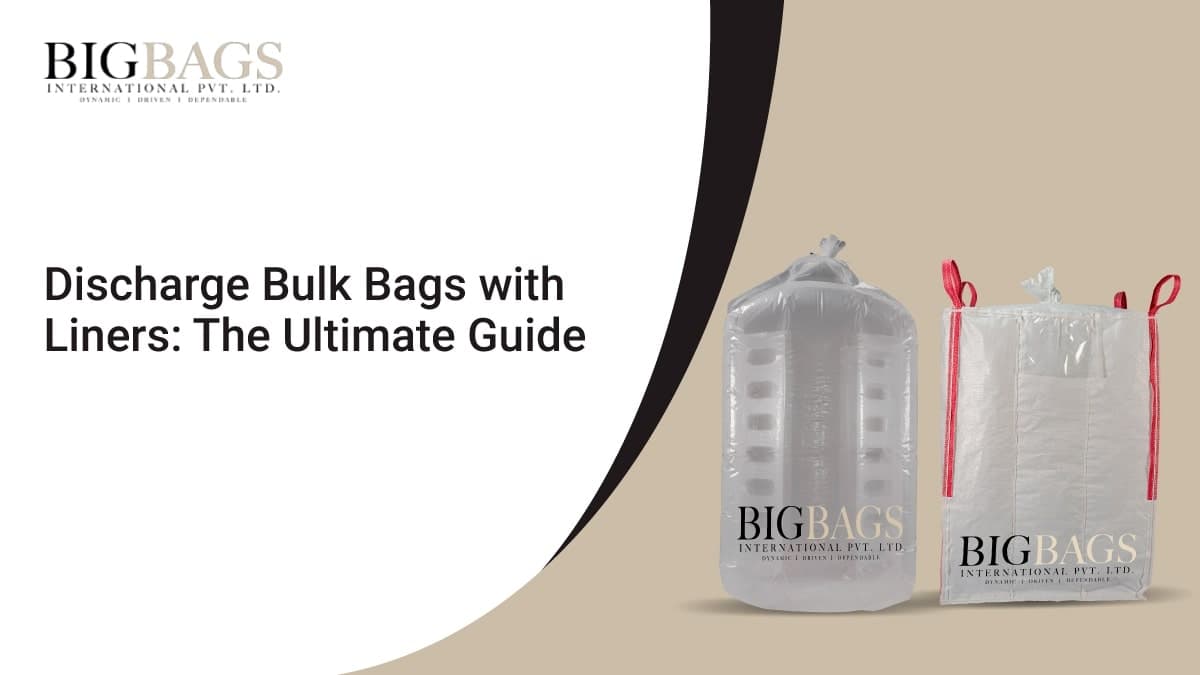
FIBC bags are a cost-efficient and flexible packaging solution for all dry-flowable goods. Depending on the nature of your business, the bulk bags manufacturer may determine the type of bag and suitable discharge options for your business. The right type of bag safeguards your product, and the right discharge system is crucial to protect on-site employees, reduce wastage, and save time.
The following guide will inform you how to discharge bulk bags with liners.
What Are Bulk Bags with Liners?
FIBCs, or flexible packaging, are made from woven polypropylene tapes which makes it a strong and sustainable packaging solution.
Many sectors such as food and beverage, agriculture, chemical fertilizers, and construction — transport goods that tend to be powdery and grainy. Because of the nature of its weave, FIBC bags allow air and moisture to seep in and fine powders may pass through the small gaps in the weave.
Bulk bags with liners prevent these finer products from sifting and spilling during transport. They also act as moisture and vapour barrier, keeping the product intact for the end consumers. Though fabric coating plays an important role, the kind of products going into the bulk bags determines whether the bag needs coating or inner liners.
What Is Discharging?
The three stages in FIBC usage are as follows:
- Filling
- Transportation
- Discharging (emptying of the bag at its final location)
There are multiple ways to discharge the FIBCs. However, the conventional method is through an outlet spout at the base of the bag.
FIBC bags are tightly filled. During discharge, the products rub up against the fabric when flowing out, resulting in the generation of static electricity.
If a bag containing flammable or hazardous products comes in contact with this static electricity, the consequences can be detrimental.
Likewise, not following proper methods to discharge bulk bags may also lead to rupturing of a bag and may lead to product loss and injure the operators using the FIBCs. Hence it’s crucial to analyze the best discharge method with the help of a trusted bulk bag manufacturer.
How To Discharge Bulk Bags with Liners?
There are two filling styles for bulk bags: spout top or full open top. The bottom construction style for discharging is either designed flat or comes with a discharge spout.
While dry items flow out easily, semi-dry or sticky products clump together and flow out in masses, which require custom-made bottoms for safe discharging.
So, depending upon the product packed in FIBC bags, you can opt for the following bottom construction styles for easy discharge.
1. Flat Bottom (No Spout)
A plain bottom is economical but not reusable, as the base of the bag is slit to discharge the material. These bags suit industries that require one-time-use FIBC.
2. Standard Discharge Spout
Standard spouts are a popular choice for discharging in the FIBC industry. The flow of discharge is directly controlled by a spout in the bottom.
With an additional flap attached to the base of the bag, discharge spouts can prevent dust and contamination of the product.
3. Conical Bottom Spout
FIBC bags with conical bottom spouts for discharge ensure all the products from the bag are completely discharged. In a flat-bottom FIBC with standard discharge spouts, materials may remain stuck in corners. A conical bottom spout is designed to solve this problem.
4. Duffle Bottom
In duffle bottom FIBC, the entire bottom of the bag fully opens to discharge the contents of the bag immediately. These types of bags are efficient for bulk items that are clumpy and come in mass. Extra precautionary measures are to be taken when dealing with duffle bottom discharge.
5. Diaper Bottom
Also called a full bottom drop, these bags have bottoms on which one side is sewn to the bag, and the other end can be tied on the other side. During discharge, the flap can be untied, so the bottom opens in its entirety, releasing all the product at once.
6. Iris Closure
Iris closure facilitates secondary protection to the discharge spout.
Tips to Safely Discharge Bulk Bags with Liners
It’s very important to follow a set of guidelines to safely pack, move, and empty your FIBC bags.
When discharging bulk bags, check if the bulk bag liner is properly supported with a bungee cord or web tie and securely connected to the bulk bag lifting device.
Before discharging, the weight of the bulk bag must be supported from the bottom with a safety frame and discharged in the proper designated discharging area.
Once the bag is resting on a safety frame, the bottom spout can be reached for discharging by the operator. Untie the cover and pull the discharge spout down completely to release the product.
Where To Get Custom Discharge Bulk Bags
If the above-mentioned types of discharging systems don’t meet your requirements, custom discharge designs are available at Big Bags.
Only an industry expert bulk bag manufacturer, such as Big Bags, can help you design the perfect flexible packaging befitting your business needs. Contact us now to receive a quote.
